


C57BL/6N-Tnfsf15tm2(TNFSF15)BcgenTnfrsf25tm3(TNFRSF25)Bcgen/Bcgen • 113082
| Product name | B-hTL1A/hDR3 mice |
|---|---|
| Catalog number | 113082 |
| Strain name | C57BL/6N-Tnfsf15tm2(TNFSF15)BcgenTnfrsf25tm3(TNFRSF25)Bcgen/Bcgen |
| Strain background | C57BL/6N |
| NCBI gene ID | 9966,8718 |
| Aliases | TL1, TL1A, TNLG1B, VEGI, VEGI192A;APO-3, DDR3, DR3, GEF720, LARD, PLEKHG5, TNFRSF12, TR3, TRAMP, WSL-1, WSL-LR |
Gene targeting strategy for B-hTL1A/hDR3 mice.
The exons 1-4 of mouseTl1agene that encode extracellular domain were replaced by human counterparts in B-hTL1A/hDR3 mice. The genomic region of mouseTl1agene that encodes transmembrane domain and cytoplasmic portion was retained. The promoter, 5’UTR and 3’UTR region of the mouse gene were also retained. The chimeric TL1A expression was driven by endogenous mouseTl1apromoter, while mouseTl1agene transcription and translation will be disrupted.
The exons 1-10 of mouseDr3gene that encode the whole molecule (ATG to STOP codon), including promoter, 5’UTR and 3’UTR were replaced by human counterparts in B-hTL1A/hDR3 mice. The human DR3 expression was driven by humanDR3promoter, while mouseDr3gene transcription and translation will be disrupted.
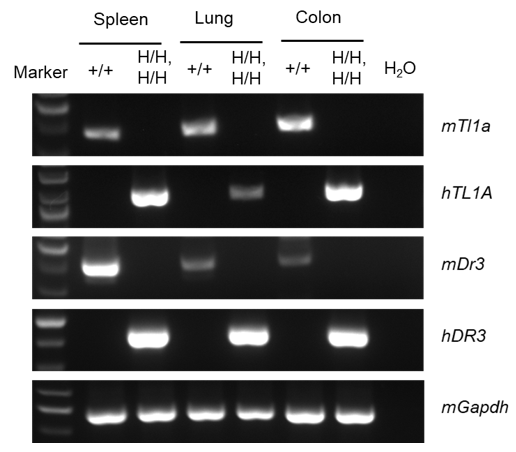
Strain specific analysis ofTL1AandDR3mRNA expression in wild-type C57BL/6N mice and homozygous B-hTL1A/hDR3 mice by RT-PCR. Spleen, lung and colon RNA were isolated from wild-type C57BL/6N mice (+/+) and homozygous B-hTL1A/hDR3 mice (H/H,H/H). MouseTl1aandDr3mRNA were detectable in wild-type C57BL/6N mice. HumanTL1AandDR3mRNA was exclusively detectable in homozygous B-hTL1A/hDR3 mice, but not in wild-type C57BL/6N mice.
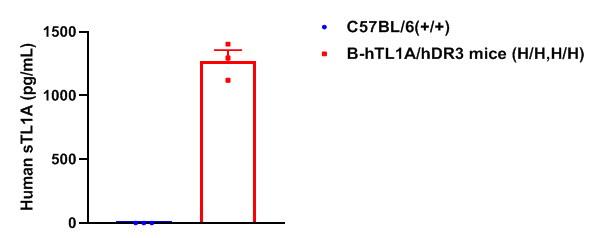
Strain specific TL1A expression analysis in homozygous B-hTL1A/hDR3 mice by ELISA. Bone marrow-derived dendritic cells were isolated from wild-type C57BL/6N mice (+/+) and homozygous B-hTL1A/hDR3 mice (H/H,H/H) and stimulated with 1 μg/mL LPS in vitro for 24 h, then cell supernatants were collected and analyzed by ELISA (anti-human TL1A ELISA kit: R&D, DY1319-05). Human TL1A was exclusively detectable in homozygous B-hTL1A/hDR3 mice but not in wild-type C57BL/6N mice.
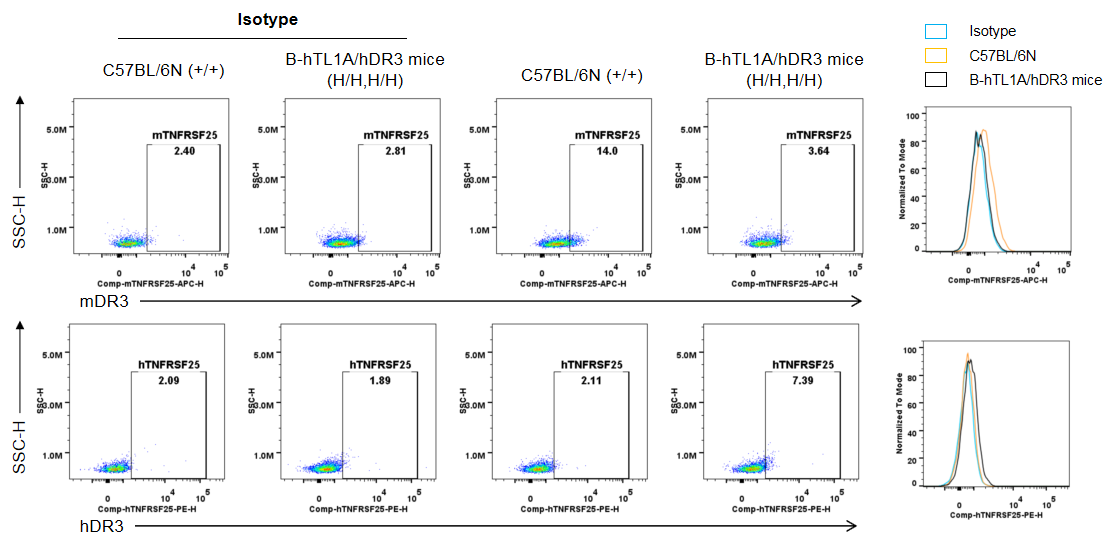
Strain specific DR3 expression analysis in homozygous B-hTL1A/hDR3 mice by flow cytometry. Splenocytes were collected from wild-type C57BL/6N mice (+/+) and homozygous B-hTL1A/hDR3 mice (H/H,H/H), and analyzed by flow cytometry with anti-mouse DR3 antibody (Biolegend,144407) and anti-human DR3 antibody (Biolegend, 307105). mDR3 was detectable on Treg cells of wild-type C57BL/6N mice, hDR3 was exclusively detectable on Treg cells of homozygous B-hTL1A/hDR3 mice.
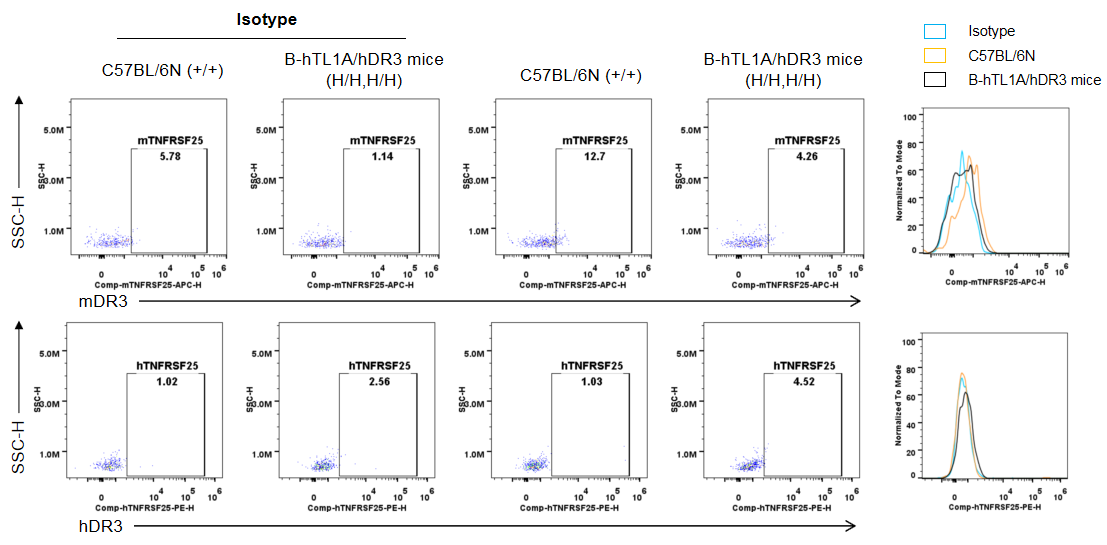
Strain specific DR3 expression analysis in homozygous B-hTL1A/hDR3 mice by flow cytometry. Blood were collected from wild-type C57BL/6N mice (+/+) and homozygous B-hTL1A/hDR3 mice (H/H,H/H), and analyzed by flow cytometry with anti-mouse DR3 antibody (Biolegend,144407) and anti-human DR3 antibody (Biolegend, 307105). mDR3 was detectable on Treg cells of wild-type C57BL/6N mice, hDR3 was exclusively detectable on Treg cells of homozygous B-hTL1A/hDR3 mice.
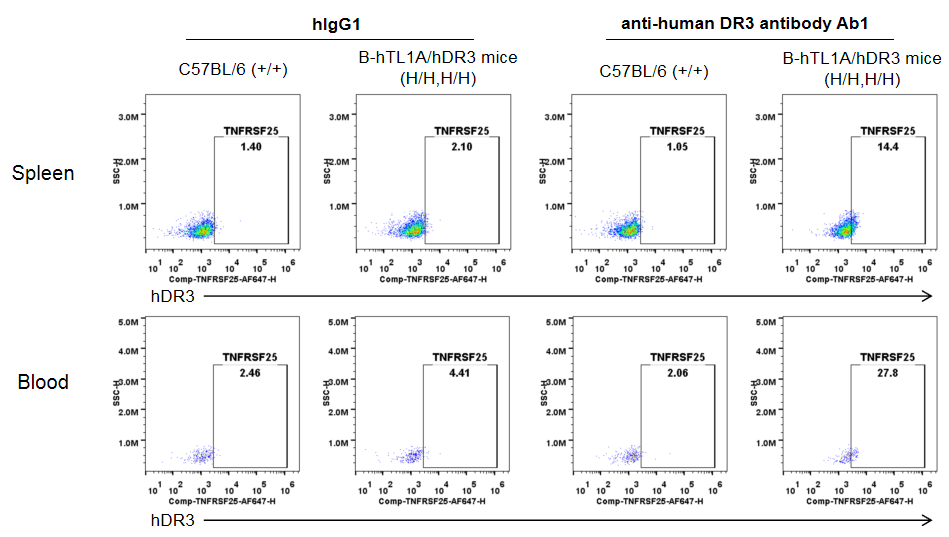
Anti-human DR3 antibody binding assessment in homozygous B-hTL1A/hDR3 mice by flow cytometry.Splenocytes and blood were collected from wild-type C57BL/6N mice (+/+) and homozygous B-hTL1A/hDR3 mice (H/H,H/H), and analyzed by flow cytometry with anti-human DR3 antibody Ab1, which is offered by the client. Ab1 can bind Treg cells of homozygous B-hTL1A/hDR3 mice.

Activation of DR3 signaling pathway increased the expansion of Treg cells in wild-type C57BL/6N mice and homozygous B-hTL1A/hDR3 mice.Wild-type C57BL/6N mice (+/+) and homozygous B-hTL1A/hDR3 mice (H/H,H/H) were given single intraperitoneal injection of DPBS, anti-mDR3 and anti-hDR3 antibodies on day 0, splenocytes and blood cells were collected on day 4 for flow analysis. The agonistic anti-mouse DR3 antibody Ab2 expanded Treg cell populations in wild-type C57BL/6N mice, and the agonistic anti-human DR3 antibody Ab3 increased Treg cells in homozygous B-hTL1A/hDR3 mice. These results contribute to a deeper understanding of DR3 activation in Treg cells modulation.
Note: This experiment was conducted by the client using B-hTL1A/hDR3 mice.